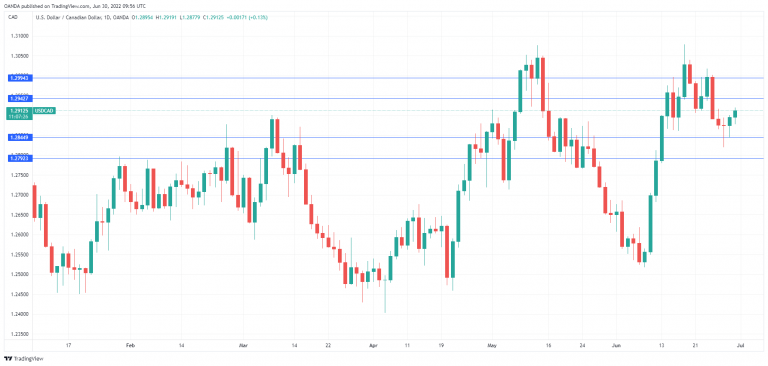The Canadian dollar is trading quietly today, just above the 1.2900 level. That could change in the North American session, with the release of Canada’s GDP for April.
GDP expected to soften
Canada’s monthly GDP releases have been pointing southwards. In March, GDP slowed to 0.7, down from 0.9% prior. The April estimate stands at just 0.3%. This is a sign of concern, although there are some bright clouds on the horizon. The war in Ukraine, which has disrupted oil and grain supplies and sent commodity prices soaring, has proved to be a boon for the Canadian economy, as Canada is the world’s fourth-largest producer of both oil and wheat. The IMF is projecting that Canada will lead the G-7 nations in growth with a GDP of 3.9%.
Canada has not been immune from spiralling inflation, as headline CPI rose to 7.7% in May, its highest level since January 1983. Similar to the Federal Reserve, the Bank of Canada has scrambled to tighten policy in order to wrestle down inflation, which has become the central bank’s public enemy number one. There are expectations that the BoC may follow the Fed’s lead and deliver a super-size 0.75% rate hike at its July 12th meeting. Inflationary pressures are broad-based across the economy, which raises the risk of inflation (and inflation expectations) becoming entrenched.
The BoC’s aggressive rate-hike cycle has led to the start of a correction in the housing market, but the long-sought-after inflation peak remains elusive. The BoC has the daunting challenge of trying to guide the economy to a soft landing – if interest rates rise more than the economy can handle, the result will be a recession. The BoC, like the Fed, appears to prefer a recession over entrenched inflation, which is why we can expect the BoC’s aggressive rate moves to continue.
USD/CAD technical
-
There is resistance at 1.2942 and 1.2994.
-
USD/CAD has support at 1.2844 and 1.2792.
This article is for general information purposes only. It is not investment advice or a solution to buy or sell securities.
Opinions are the authors — not necessarily OANDA’s, its officers or directors. OANDA’s Terms of Use and Privacy Policy apply. Leveraged trading is high risk and not suitable for all. You could lose all of your deposited funds.
Recommended Content
Editors’ Picks
AUD/USD could extend the recovery to 0.6500 and above

The enhanced risk appetite and the weakening of the Greenback enabled AUD/USD to build on the promising start to the week and trade closer to the key barrier at 0.6500 the figure ahead of key inflation figures in Australia.
EUR/USD now refocuses on the 200-day SMA

EUR/USD extended its positive momentum and rose above the 1.0700 yardstick, driven by the intense PMI-led retracement in the US Dollar as well as a prevailing risk-friendly environment in the FX universe.
Gold struggles around $2,325 despite broad US Dollar’s weakness

Gold reversed its direction and rose to the $2,320 area, erasing a large portion of its daily losses in the process. The benchmark 10-year US Treasury bond yield stays in the red below 4.6% following the weak US PMI data and supports XAU/USD.
Bitcoin price makes run for previous cycle highs as Morgan Stanley pushes BTC ETF exposure

Bitcoin (BTC) price strength continues to grow, three days after the fourth halving. Optimism continues to abound in the market as Bitcoiners envision a reclamation of previous cycle highs.
US versus the Eurozone: Inflation divergence causes monetary desynchronization

Historically there is a very close correlation between changes in US Treasury yields and German Bund yields. This is relevant at the current juncture, considering that the recent hawkish twist in the tone of the Federal Reserve might continue to push US long-term interest rates higher and put upward pressure on bond yields in the Eurozone.
